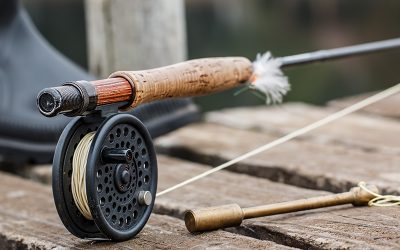by Mike Buss, Virginia Coastal Fly Anglers, March 2017
This month let’s talk about streamers. Streamers are typically designed and tied to imitate the color, size, shape, or action of a baitfish. The more of these characteristics the fly has, the more effective it will be.
These flies can range in size from an inch to over a foot in length and can be designed to fish the entire water column from the surface to the bottom with the addition of weight in the fly design.
Weight can be added to the fly in a number of ways. It can be wrapped around the shank of the hook prior to adding the hair or feathers to complete the fly. This will allow the fly to sink at a uniform rate without tipping down. If you want the fly to sink with the head down, you can add weight in the form of lead eyes or a cone to the front of the fly. This will allow the fly to sink head first and with a tug on the fly line on the retrieve, the fly will shoot up before sinking head first again just like an injured baitfish.
Of course, you can use sinking lines to get your fly down in the water column as well. Combine a full sinking line with a fly with weight to get your fly down to twenty-five feet or more. This is one of my favorite ways to fish in saltwater when the fish are deep. To fish this way, you determine which way the current is flowing to determine how your boat will be drifting and then cast in that direction and as your boat is floating down to your line and fly, your fly and line will be sinking deep into the water column. When you reach your line, your fly should be down deep and can then be retrieved. The strike often comes with the first few strips of your line as your fly makes an upward movement.
If you are fishing in water less than five feet, I often use a floating line and a streamer with no weight. You simply cast your fly to a likely looking spot and then let the fly slowly sink, almost suspending in the water column just like the popular conventional tackle suspending baits. Again, the strike will usually come when you begin your retrieve as the suspended fly suddenly comes alive and moves.
If you are fishing in water from five to ten feet, I will use an intermediate sinking line and a fly with some weight to get it down quickly. You make a cast to a likely looking spot and then give your fly some time to get down in the water before starting your retrieve. You should keep a tight line as the fly is sinking as you often get a strike on the fall. If you feel something strange, a fish has probably taken your fly and make a strip strike and game on.
Virginia guide and fly tier Blane Chocklett has pioneered a system of articulated fly tying that has revolutionized streamers. This system incorporates a system of five to seven joints that allow the fly to wiggle when retrieved just like a baitfish. He calls his flies Game Changers and they are tied in various sizes and colors to match the local baitfish. ome of them are also weighted.
I have come to use these Game Changers when I fish in rivers and streams. I simply make a quartering cast and let the fly drift with the current until it reaches the end of the line and then I let it swing and wiggle in the water just like a baitfish. I retrieve it a little and if I don’t get a strike, I let it settle back and I keep doing this until I hook up and it usually doesn’t take too long.
Streamers have been around for a long time and there is a reason for that, they work and catch fish. It’s up to you to get out and find out for yourself.
